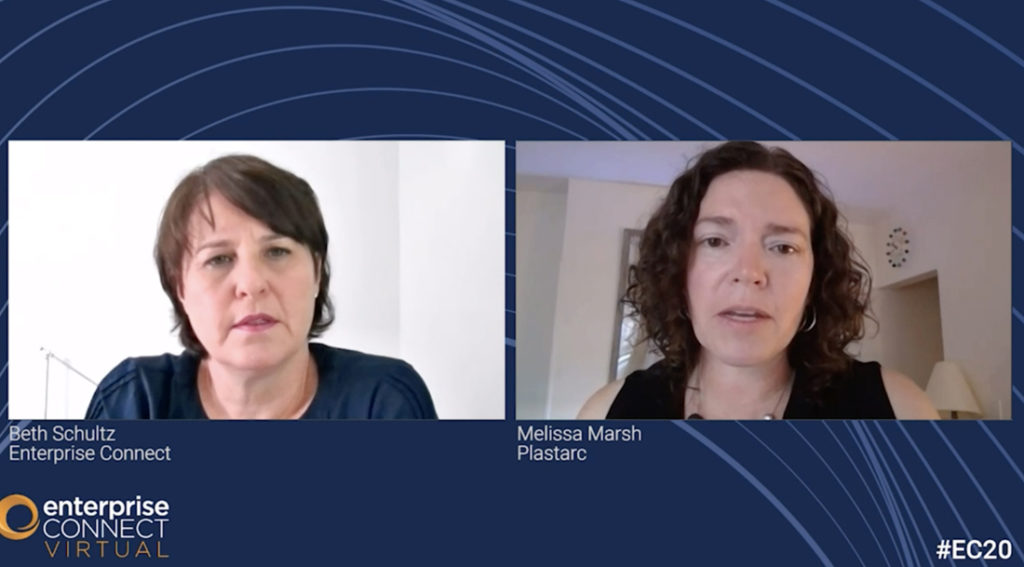As IT professionals look to the year ahead, one timely issue is delivering the right level of support to enhance the performance of both remote and on-premise workers. While some organizations have signaled their willingness to allow permanent work-from-home, most enterprises will see employees return to the office on a regular basis – particularly when an effective COVID-19 vaccine or therapy is available.
“Office spaces foster connectivity and collaboration,” said Melissa Marsh, founder and executive director of PLASTARC, a social research firm that focuses on the built environment. “The people-centric nature of the workplace will continue as organizations return to the office.”
Beth Schultz, program co-chair, No Jitter, led a discussion with Marsh on “Balancing Distributed and Office Work at a recent Enterprise Virtual Connect session. Schultz asked about how workplaces can operate more effectively from a health and wellness perspective as well as supporting individual and team performance.
Marsh emphasized the importance of technology in managing offices and other types of commercial real estate facilities, and pointed to several issues for IT professionals to consider:
- Smart buildings. Gathering data from the HVAC systems in order to track energy use, identify problems, and send real-time alerts when necessary.
- Health and wellness features. This might mean creating an airflow diagram of the office space or installing new filters that can capture viruses and other small particles.
- Creating collaborative spaces. Along with equipping meeting rooms of all sizes, common areas like lobbies or lunchrooms could also be fitted with collaboration technology.
- Outdoor spaces. Depending on building configuration, climate, and weather conditions, IT professionals could support collaborative sessions on a patio, terrace, rooftop, or lawn.
- Touchless services, such as hailing an elevator or booking a meeting room from an app on a mobile device.
“You want to think about how you can use technology in buildings to drive the user experience,” said Marsh. “Workers need to feel safe and comfortable in order to be productive on the job.”

What about remote workers?
Turning to the remote workforce, Marsh said IT professionals need to think beyond the traditional scope of technology to engage and support employees working from their homes or other remote locations.
“Our data shows that people are having a better than expected telework experience, but there are still many things that can be done,” she said. “That might mean providing ergonomic chairs, dual monitors, better lighting, or even advice on how to be more physically active in a home workplace.
Looking ahead, Marsh said she expects that flexible scheduling will continue to be an important component of the user experience. For instance, a manager or supervisor might come into the office two days a week, while directing the front-line team from a home office on other days. That suggests configuring more office spaces for hoteling arrangements where employees can plug in their devices and log in to the network.
For IT professionals, the need to support employees in both environments is likely to accelerate the migration to the cloud. After all, users want the ability to access their applications and data from the same interface regardless of device or location.
Marsh also hopes that a return to the office won’t jeopardize the egalitarian nature of the current communication and collaboration environment. “When everyone is connecting virtually, there are no haves and have nots,” she said. “We need to maintain that sense of equality and inclusiveness when we bring people back to the physical workplace.”

Thanks for sharing superb informations. Your web-site is very cool. I’m impressed by the details that you¦ve on this web site. It reveals how nicely you perceive this subject. Bookmarked this website page, will come back for extra articles. You, my friend, ROCK! I found simply the information I already searched everywhere and simply could not come across. What a perfect website.
Excellent read, I just passed this onto a colleague who was doing some research on that. And he actually bought me lunch because I found it for him smile Thus let me rephrase that: Thanks for lunch! “To be 70 years young is sometimes far more cheerful and hopeful than to be 40 years old.” by Oliver Wendell Holmes.